

|
|
| « Previous | Next » |
| Warm Waters Run Deep | Sunday, 31 October 2004 |
| written by Teresa |
Vast areas of Idaho are virtually devoid of significant population centers. Interstate runs in a smiling crescent near the southern border, linking Boise and Idaho Falls on a necklace studded with a string of small towns. Away from the corridor it is a different story; towns more the size of villages serve large areas of surrounding ranch land, their skylines distinguished by the characteristic spires of Latter-Day Saint churches.
The normally dry earth of this high semi-desert area has been desiccated further by seven years of drought. Pale yellows and washed out sage greens clothe the land under a weak autumnal light, surrounded by mountains already dusted with the first layer of this years snow.
The austerity of the landscape seems somehow reflected by its people. In other western states, driving on the minor roads is an exercise in what the Americans call neighborliness; everybody waves or at least nods or raises a finger from the steering wheel in acknowledgement. They know we don't live locally but good manners and an inherent friendliness prevail and we are included in this custom. Here in Idaho not one passing vehicle has initiated a greeting and our waves have been ignored. It seems as though people here don't smile as easily or readily as those we have met elsewhere and while there have definitely been exceptions the overall impression has remained.
While potatoes may be the crop most often associated with Idaho, sugar beet is the root of the moment. In the valleys the harvest is underway and the roads busy with lorries piled high with the earthy vegetable; they congregate at depots, queuing to disgorge their bounty onto huge mountains of proto-sugar. A hint of the state's stereotype is glimpsed in the occasional sign proclaiming "Potatoes for Chips", that's crisps really, but in spite of our expectations we saw no evidence of them outside of the supermarkets.
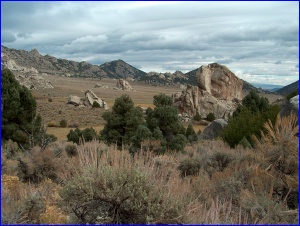 City of Rocks National Reserve is an isolated area not far from the Utah border, reached by miles of dirt track. The Reserve is part of the National Parks but managed by the State of Idaho, its designation coming from its particular nature. Unlike other parts of the NPS, here private land is maintained within the boundaries and Native American rights to gathering pine nuts are upheld.
City of Rocks National Reserve is an isolated area not far from the Utah border, reached by miles of dirt track. The Reserve is part of the National Parks but managed by the State of Idaho, its designation coming from its particular nature. Unlike other parts of the NPS, here private land is maintained within the boundaries and Native American rights to gathering pine nuts are upheld.
Approaching its border the name suddenly makes sense as the gentle contours of the sage covered hills give way to huge granite outcrops packed closely together like a town from another world. The rock is pale, its edges eroded into curves, its surfaces pocked by pan holes, eaten away by rain water, some large enough to sit in. The inter-rock areas are soft underfoot, a granite sand feeding the pale semi-desert vegetation, an odd copse of aspen leafless in the cool bowls nestled amongst the surrounding edifices.
There is a warren of trails meandering through the streets, following the alleys between the houses and emerging into wide-open spaces on the edge of the town. The air is cool and small flurries of snow accompany us from time to time.
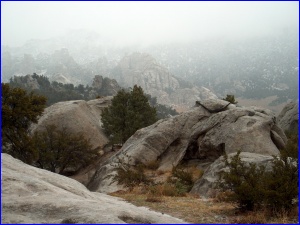 It is a place of silence, the Junipers and Pinions brushed by the passing breeze, the stillness disturbed only by the foraging birds and the movement of deer.
It is a place of silence, the Junipers and Pinions brushed by the passing breeze, the stillness disturbed only by the foraging birds and the movement of deer.
When the cloud descends our visible world shrinks: vistas disappear and the middle distance vanishes. Along with the surrounding rock we are enshrouded in a thick swirling mist, heavy rain a constant percussion on the camper. The day passes enfolded in a greyness of eternal dusk and while it's a good opportunity to do a bit of work, there is still some sense of being trapped. It reminds me a little of being a child, waiting for the rain to stop, watching the water run down the outside of the windows, entrapped in the ennui of inactivity.
The spell was broken the next morning as we left under only partly overcast skies, heading for the tiny town of Lava Hot Springs and the promise of a dip in the warm waters. This proved to be an understatement of expectation, the temperature of the pools nearing 110 degrees and in our experience far too hot for prolonged soaking in the required manner. It seemed a shame, as the pools themselves were quite a delight. The two large pools of irregular shape, their floors covered in gravel, the two smaller ones lined in a crazy paving of local rock, their waters churning gently with the high rate of through flow. After only an hour we departed, our skins a florid colour of pink, flamingo impersonations unfortunately inappropriate in the cool climate. At least the air temperature was cold; I dread to think what it would be like in the height of summer. Our considered opinion, hotter is not necessarily better.
The town itself is basically a one street wonder, a few hundred feet of tourist shops intermingled with a handful of bars and restaurants, a grocery shop, bank, visitor center and of course numerous motels. We spent the night in a small RV park tucked at the back of one of the local hostelries on the bank of the Portneuf River.
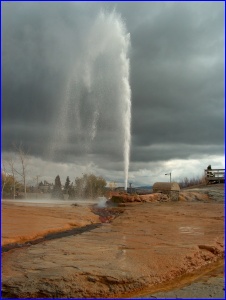 Just up the way, steam rose from the bank where a spring mixed with the colder flow and the pervasiveness of the underground mechanisms at work was further revealed by the fact that the water in the campground was warm from the tap.
Just up the way, steam rose from the bank where a spring mixed with the colder flow and the pervasiveness of the underground mechanisms at work was further revealed by the fact that the water in the campground was warm from the tap.
We slowly cooled and regained a more natural skin tone as we drove towards Soda Springs and the oddity of an accidentally created geyser. In 1937 Soda decided it wanted a swimming pool and set about trying to tap into a naturally occurring source of warm water. In the process of drilling 315 feet they hit what is now the clockwork marvel of their town. Extreme pressure is caused by carbon dioxide gas mixing with water in a subterranean chamber and this is now capped and controlled by a timer; it goes off every hour on the hour. In spite of its artificial regularity and creation it is still quite impressive, shooting high into the sky, rainbows gently colouring the spray as the breeze whisks the water away from the main column.
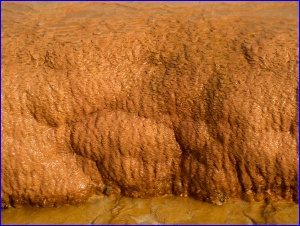 The run off area is a complex mound of orangey mineral deposits, algae covered channels marking the favoured passage of the warm water. The adjacent car park carries warnings of the danger of mineral spots appearing on cars left when the wind is in the wrong direction and looking at the build up on the ground it's maybe wise to take heed.
The run off area is a complex mound of orangey mineral deposits, algae covered channels marking the favoured passage of the warm water. The adjacent car park carries warnings of the danger of mineral spots appearing on cars left when the wind is in the wrong direction and looking at the build up on the ground it's maybe wise to take heed.
One puzzling aspect to this wonder is the town's claim that it is "the only man-made Geyser in the world". Now if memory serves me, we came across another artificial geyser in Oregon last year; that one blew every ninety seconds, again the product of drilling for water, this time for a hot springs resort. Maybe the good people of Soda don't know about it, or at least didn't when they made their sign board proclaiming the originality of their particular water feature.
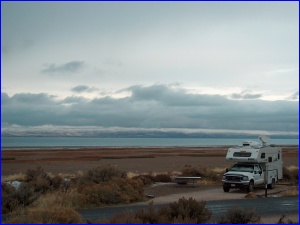 Either way it beats having a fountain issuing from the mouth of a dolphin.
Either way it beats having a fountain issuing from the mouth of a dolphin.
We left the land of warm waters and headed for the cooler ones at Bear Lake and a last night in Idaho. A wide beach surrounds the water, the sand revealed by the drought-shrunk reservoir. Gentle afternoon sunlight highlighted the pale yellow grasses along the shores, accentuating the contrast with the dark water and looming sky. Snow dusted the hillsides and cloud hung in linear pockets over the water, the scene gradually turning to monochrome as the light faded.
| « Previous | [ Photos ] | [ Map ] | Next » |
Do you know someone who would enjoy this article? Click to e-mail it to them!
| Home | Log | Notes | Maps | Contact | Store |